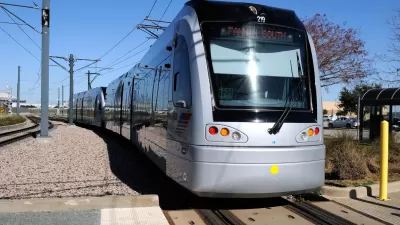Over the past decade more than $75 billion in public dollars has been invested in rail transit. Los Angeles, Seattle and Denver alone are investing an additional $65 billion to expand their systems and enhance the livability of their communities. The federal government will be asked to play a major role in funding each of those systems. Up until now the federal role in major transit investments has largely avoided the question of how we ought to design our transit systems to be good neighbors and leverage livable communities.
Over the past decade more than $75 billion in public dollars has been invested in rail transit. Los Angeles, Seattle and Denver alone are investing an additional $65 billion to expand their systems and enhance the livability of their communities. The federal government will be asked to play a major role in funding each of those systems. Up until now the federal role in major transit investments has largely avoided the question of how we ought to design our transit systems to be good neighbors and leverage livable communities.
The Federal Transit Administration (FTA) is currently considering options for streamlining and improving the evaluation process they use for determining which major transit projects to recommend for funding. FTA's "New Starts" process is the major source of federal capital funding for new streetcar, light rail and subways lines.
For decades in rating New Starts projects FTA has dug deeply and comprehensively into factors such as financial capacity, ridership forecasts, and user benefits. At the same time FTA has been ambivalent on the biggest question in the room: the design of transit facilities to capture the user and community benefits FTA has been seeking to quantify. For too long the conversation has been about transit efficiency and what local governments can do to change land use. The attention needs to turn to improving transit design as well. Continuing to follow the old transit facility design playbook is not going to work if we want livable communities. As a first step FTA needs to highlight the importance of good design to encourage transit agencies to deliver projects that embrace the principles of livable communities. Good design need not cost more, but certainly the New Starts process should not be structured with built-in disincentives for good design.
For the past decade there has been a brewing debate in the highway and land use world about improving the design of transportation facilities to get better outcomes. Now is the time to follow the lead of Federal Highway Administration and their work on context sensitive highways and for FTA to delve into context sensitive transit design. Independent of mode, the design of transit facilities matters tremendously in capturing the economic development, environmental, land use and mobility benefits of transit investments. Not addressing design is a very big gap in the current federal program. The placement of a station, the size and location of commuter parking, how a transit facility fits into or is separated from a community each make a big difference on transit system performance. It also can make a huge difference with realizing the Obama Administrations six Livability Principles http://www.dot.gov/affairs/2009/dot8009.htm. The transit industry and local governments will welcome and encourage federal involvement to encourage better design outcomes.
My home of Portland serves as a case in point – the region has seen some $11 billion in transit-oriented development occur next to its light rail and streetcar stops. Over the past three decades as the region moved more and more to embrace livable communities as an aspect of transit investments there has also been an evolution in how the region approaches the selection of corridors, station locations, sizing and location of parking, transit facility design, and the scope of what activities are included in a transit project. The point here is not that others should mirror Portland's design; rather the lesson from Portland and elsewhere is that transit design matters when you are trying to build communities and move people. Unfortunately there are many examples of transit agencies that have not evolved in the design and construction of transit facilities to the detriment of leveraging livable communities.
Short of mandating design FTA could provide guidance, best practices, or require peer reviews to encourage a transit design process that supports livable communities. Hopefully FTA will go further and provide built-in incentives in their land use and economic development evaluation to design transit in such a way that it encourages walkable transit-supportive development patterns. Too much is at stake in the livability of our urban areas, now is the time for the federal for the government to acknowledge and act like design matters.

Planetizen Federal Action Tracker
A weekly monitor of how Trump’s orders and actions are impacting planners and planning in America.

Chicago’s Ghost Rails
Just beneath the surface of the modern city lie the remnants of its expansive early 20th-century streetcar system.

San Antonio and Austin are Fusing Into one Massive Megaregion
The region spanning the two central Texas cities is growing fast, posing challenges for local infrastructure and water supplies.

Since Zion's Shuttles Went Electric “The Smog is Gone”
Visitors to Zion National Park can enjoy the canyon via the nation’s first fully electric park shuttle system.

Trump Distributing DOT Safety Funds at 1/10 Rate of Biden
Funds for Safe Streets and other transportation safety and equity programs are being held up by administrative reviews and conflicts with the Trump administration’s priorities.

German Cities Subsidize Taxis for Women Amid Wave of Violence
Free or low-cost taxi rides can help women navigate cities more safely, but critics say the programs don't address the root causes of violence against women.
Urban Design for Planners 1: Software Tools
This six-course series explores essential urban design concepts using open source software and equips planners with the tools they need to participate fully in the urban design process.
Planning for Universal Design
Learn the tools for implementing Universal Design in planning regulations.
planning NEXT
Appalachian Highlands Housing Partners
Mpact (founded as Rail~Volution)
City of Camden Redevelopment Agency
City of Astoria
City of Portland
City of Laramie





























